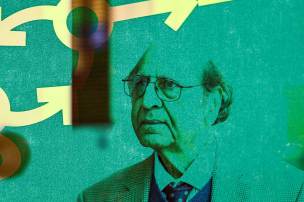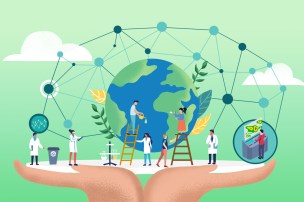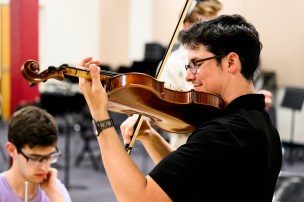Published on
‘Landmark in survey research’: How the COVID States Project analyzed the pandemic with objectivity
Four years ago David Lazer formed the Northeastern-led effort — resulting in more than 100 cutting-edge reports and national media coverage.

David Lazer ran into a fellow Northeastern University professor Alessandro Vespignani. It was February 2020. One month before the COVID-19 shutdowns.
“I said, ‘Tell me: How bad is it going to be?’” says Lazer, University Distinguished Professor of Political Science and Computer Sciences at Northeastern. “And he laid out how bad it would be.”
They were facing a life-changing event, warned Vespignani, director of the Network Science Institute and Sternberg Family Distinguished Professor at Northeastern. SARS-CoV-2, the virus that causes COVID-19, was spreading fast throughout the U.S. and beyond just three months after its emergence in Wuhan, China.
“He talked about how things were going to shut down over the following month and how there was going to be an indefinite time of having to modify our lives in order to protect ourselves individually and collectively,” Lazer recalls of that conversation. “He really got the broad parameters spot on.
“I obviously was quite distressed. I was thinking, ‘What can I do to contribute to the moment?’”
The answer would become known as the COVID States Project, a Northeastern-led effort by four universities that would analyze newly collected data in order to make sense of the evolving and volatile COVID-19 pandemic.
Over the next four years the project would put out more than 100 reports — all relevant to urgent issues — that were reflected by media coverage across the country.
Sharing their expertise across a variety of fields — computational social science, network science, public opinion polling, epidemiology, public health, psychiatry, communication and political science — the researchers framed and conducted surveys that enabled them to identify national and regional trends that influenced (and were influenced by) the spread of the virus.
“It was an act of improvisation — we didn’t know exactly what we were going to do,” Lazer says. “But we felt quite committed to having a positive impact and using our tools, our skill set, to do something during this horrible moment.”Built into their real-time research was an understanding that social behaviors would play a large role in a pandemic that has claimed close to 1.2 million lives nationally, according to the Centers for Disease Control and Prevention (though there is reason to believe many more people have died).

The project’s surveys and reports reflected national moods and trends while also providing reliable information for policymakers at a time when the future was difficult to predict.
“David, being a political scientist, told me that he had this idea that a survey would be helpful,” says Mauricio Santillana, an original member of the COVID States Project who has since joined Northeastern as director of the Machine Intelligence Group for the betterment of Health and the Environment (MIGHTE) at the Network Science Institute. “I told him it was very appropriate because rather than seeing a population reaction to a public health crisis, the pandemic was evolving into a sociological problem — one where people were reacting more from their political views rather than scientific evidence.
“He had this idea of having a project where we could monitor people’s feelings, emotions and their changing behaviors in response to pronounced increases in COVID-19 infections and we could record their political affiliations,” adds Santillana, who was focused on mathematically modeling the pandemic. “The project became a really important tool for me to understand why things were getting worse and worse.”
Their work was based in objectivity — the need to respect all points of view while prioritizing understanding and dismissing judgment.
“By shedding light on things in a way that has visibility,” Lazer says, “one hopes that you are informing individual people who are reading about our stories in the media as well as policy elites about what decisions should be made.”
‘The best data out there’
It began with Lazer contacting colleagues at other universities. The COVID States Project became an effort coordinated by Lazer, Santillana, Matthew Baum and Roy Perlis of Harvard, Katherine Ognyanova of Rutgers and James Druckman of Northwestern. Weekly meetings were held at 10 a.m. on Fridays as the project grew to include undergraduate and postdoctoral students — all contributing on a volunteer basis.
“We went out into the field in April and we started collecting data,” Lazer says. “We realized that we could get useful results for all 50 states. We could see the numbers pile up and that was an exciting moment, like, maybe this thing can actually work.”
Northeastern provided the startup funding (and many of the volunteers, and much of the person power, as authors of project reports included three postdoctoral fellows and six students from Northeastern). Additional financial support would come from the National Science Foundation, the National Institutes of Health and other supporters that enabled the project to grow and expand. The project’s work on COVID-19 is continuing even now.
“We’re still putting out data on vaccination rates and infection rates,” says Lazer, whose team relied on a third-party vendor for online surveys that represent a new frontier for public polling. “It turns out that our data are better than the official data, because the official data are seriously flawed in important ways.”
Those official numbers can be faulty because individual states have difficulty linking residents with the number of vaccinations they’ve received, says Lazer.
The COVID States Project team has learned how to not only frame questions with the precision to deal with relevant issues, but also to re-weigh the answers to provide representative analysis.
“If you want to know the vaccination rates of a given state, I think our data are the best data out there,” Lazer says. “It’s pretty mind-blowing that we have done 1,400 to 1,500 state-level surveys.”
Initial efforts were focused on understanding the basics of the pandemic. While all 50 states were developing plans to reopen for business in June 2020, the project found that most people preferred a more cautious approach, with only 15% of respondents favoring an immediate reopening.
“The project is a landmark in survey research,” says Alexi Quintana Mathé, a fourth-year Ph.D. student working with Lazer at Northeastern. “We surveyed more than 20,000 respondents roughly every month, with viable samples in every U.S. state and good representativity of the general population. This allowed us to closely monitor behaviors, opinions and consequences of the COVID-19 pandemic across the country with a special focus on differences by state, which were particularly relevant during the pandemic.”
Their work was able to show that Black people waited longer for test results than other people in the U.S.
“It’s important to illuminate and create accountability,” Lazer says.
The project’s tracking of social distance behaviors in October 2020 helped predict which states would experience surges the following month.
A survey in summer 2020 accurately predicted the rates of people who would submit to vaccinations when the shots became available that December. Another survey was able to show which demographic groups would be reluctant to be vaccinated.
“The team found that concerns over vaccine safety, as well as distrust, were key reasons [for reluctance],” says Kristin Lunz Trujillo, now a University of South Carolina assistant professor of political science who worked on the COVID States Project as a Northeastern postdoctoral fellow. “This report sparked a lot of other ongoing work on the project and gave a fuller picture of COVID vaccine hesitancy than what our typical survey measures provided.”
“People still needed to be convinced, and I think that was a very natural response,” says Santillana, a Northeastern professor of physics and electrical and computer engineering. “The fact that people were concerned about their health when being exposed to a vaccine is a natural thing. But that was being interpreted as, ‘Oh, then you are a denier.’ There was no room to be a normal person who wants to learn as we experience things. For me, being a mathematician and physicist and hearing my political-scientist colleagues discussing issues of trust in medical research and medical professionals, it became a multidisciplinary learning experience.”
A constructive role by academia
In the midst of their COVID-19 work, the researchers delved into other major U.S. events. They were able to identify the demographics of the widespread Black Lives Matter protests that followed the May 2020 murder of George Floyd. And they were able to show that those outdoor protests did not result in upsurges of pandemic-related illness.
“The diverse expertise of scientists on the project meant that we could investigate public health issues both broadly and deeply,” says Alauna Safarpour, a Northeastern postdoctoral contributor to the project who now serves as assistant professor of political science at Gettysburg College. “We not only analyzed misinformation related to the pandemic, vaccine skepticism and depression/mental health concerns, but also abortion attitudes, support for political violence and even racism as a public health concern.”
In anticipation of the role that mail-in ballots would play in the 2020 election, the project anticipated which state results would change as the late-arriving votes were counted.
“We had a piece predicting the shift after Election Day,” Lazer says. “We said there’s going to be a shift towards Biden in some states and it will be a very large shift — and we got the states right, we got the estimates right.
“We were trying to prepare people that there was nothing fishy going on here. That this is what is expected.”
After the insurrection of Jan. 6, 2021, the project predicted accurately that Donald Trump would retain his influence as leader of the Republic Party.
“There were a lot of people right after Jan. 6 who said Trump is finished,” Lazer says. “We went into the field a couple of days later, did a survey and we said, ‘The [typical] Republican believes the election was stolen and says Trump’s endorsement would still matter a lot.’”
The Supreme Court’s overturning of Roe v. Wade in June 2022 was followed by a COVID States Project report accurately forecasting a Democratic backlash.
“There’s a story here around the constructive role that academia can play in moments of crisis — the tools that we have are really quite practical,” Lazer says. “As the information ecosystem of our country has diminished — we see the news media firing people left and right — there is a role for universities to take some of that capacity for creating knowledge and translating that to help with the crises of the day.”
Next up: CHIP50
“It uncovered the impact of the social and political changes that Americans went through over the last four years at the national level, but more importantly it broke down the findings to demographic and regional groups,” says Ata Aydin Uslu, a third-year Ph.D. student at the Lazer Lab at Northeastern. “I see CSP as a successful attempt to mic up the American public. We enabled Americans to make their point to the local and federal decision-makers, and the decision-makers to make informed decisions and resource allocations — something that was of utmost importance during a once-in-a-century crisis.”
Entering its fifth year, the project is taking on an identity to reflect the changing times. The newly named Civic Health and Institutions Project, a 50 States Survey (CHIP50) is building on the lessons learned by the COVID States Project team during the pandemic.
“The idea is to institutionalize the notion of doing 50 state surveys in a federal country,” Lazer says. “We have this perspective on states that no other research ever has.”
Their ongoing work will include competitions to add questions from outside scholars, Lazer says. “We’re still going to issue reports, but less often, and we’re going to be turning more to scholarship while still trying to get that translational element of what does this mean, what people should think, what policymakers should do and so on.”
During a recent interview, as Lazer is recounting the work of the past four years via a Zoom call, his head is bobbing back and forth. When the pandemic forced him to isolate, he explains, he made a habit of working while walking a treadmill in his attic. At times he was responding to the pressures of the pandemic by working 16 hours while logging 40,000 steps daily — and developing plantar fasciitis along the way.
“All of this has made me think much more about the underlying sociological and psychological realities of how people process information — and the role that trust in particular plays,” Lazer says. “It has really shaped my thinking about what is core in understanding politics.”
Ian Thomsen is a Northeastern Global News reporter. Email him at i.thomsen@northeastern.edu. Follow him on X/Twitter @IanatNU.





